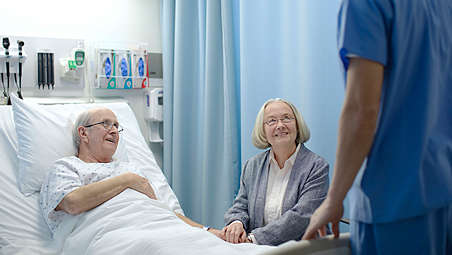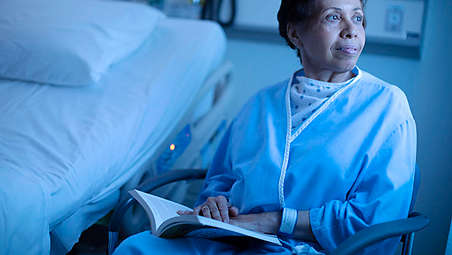Specifications
- Physical specifications
-
Physical specifications Size - 96 mm x 61 mm x 7.1 mm (3.78 in x 2.40 in x 0.28 in) without release liners
Weight - 10 g (0.35 oz)
Battery - CR2032, 3V primary cell
Memory - 1 MB, non-volatile flash
Durability - Survives shock & vibration per IEC60721-4.7; Class7M2; survives free fall (1 m drop) per IEC 60601-1
Water ingress protection - IP27 (IEC 60529:2013)
Latex - Not manufactured with natural rubber latex
-
- Usage specifications
-
Usage specifications MRI safe - No
Single use - Yes, single use only
Operational life - Biosensor can be chest-worn up to 120 hours (5 days)**
Disosable - Yes
Serviceable - No
-
- Performance
-
Performance Respiration rate measurement - 3-40 respirations per minute (rpm)
Respiration rate accuracy - ±3 rpm (excluding periods of undefined respiration rate due to patient talking, eating or coughing)
Respiration rate resolution - 1 rpm
Heart rate measurement - 30 - 220 beats per minute (bpm)
Heart rate accuracy - 10% or ±5 bpm (whichever is greater)
Heart rate resolution - 1 bpm
Heart rate calculation - Takes into account last 10 beat-to-beat intervals; excludes min/max intervals
Heart rate meter response time - Heart rate changes: 80–120 bpm captured within 8 sec ±2 sec; 80–40 bpm captured within 16 sec ±2 sec
ECG sampling rate - 250 samples per second
Applied part classification - Defibrillation-proof type CF applied part
Applied current - 16 µA (max), 40 kHz current pulse is applied to the patient
Tall T-wave detection - Up to 1.5 mV peak to peak is rejected
Pace pulse detection - Amplitudes ±2 mV–±700 mV; pulse widths 0.1 ms–2 ms; rise time ≤10% of the pulse width, but ≥100 μs
Device & algorithm performance - Meets IEC 60601-2-27:2011, IEC 60601-2-47:2012 and AAMI EC57 for heart rate measurements
Activity level - 0 = at rest, 1 = low activity, 2 = moderate activity, 3 = high activity
Ambulation - Ambulating or not ambulating
Posture - Lying down (left or right side, supine, prone or reclining) or upright***
Data transmission interval - 1 minute
Local storage - 4 hours
-
- Wireless/Security
-
Wireless/Security Radio - Bluetooth low energy (4.2)
Frequency band - 2402 - 2480 MHz
RF radiated power output - Transmit power 0 dBM (1 mW)
Range - 100 feet (line of sight)
Modulation scheme - Frequency shift keying (FSK)
Security - Data in rest: AES 128-bit (ECB mode); Data in transit: AES 128-bit (CCM mode)
-
- Environmental
-
Environmental Operating ambient temperature - +10°C to +40°C (+50°F to +104°F)
Operating humidity - 10 - 95% relative humidity limit (non-condensing)
Operating atmospheric pressure - 70 – 102 kPa (10.15 psi – 14.80 psi)
Shipping temperature - -20°C – +40°C (-4°F – +104°F); time limit 48 hours
Shipping humidity - 5 – 95% relative humidity (non-condensing)
Shipping atmospheric pressure - 70 – 102 kPa (10.15 psi – 14.80 psi)
Storage temperature - +10°C – +40°C (+50°F – +104°F)
Storage humidity - 5 – 95% relative humidity (non-condensing)
Storage atmospheric pressure - 70 – 102 kPa (10.15 psi – 14.80 psi)
Shelf life - 12 months in individually sealed pouch
-
- Product ordering information
-
Product ordering information Biosensor BX100 - 10 per box
Multi-patient bridge (single Bluetooth router, power supply, USB cable, international wall outlet adapters, mounting plate and screws) - 1 per box
Power supply, USB cable and international wall outlet plug adapters - 1 per box
Mounting plate and screws - 1 per box
-
- Physical specifications
-
Physical specifications Size - 96 mm x 61 mm x 7.1 mm (3.78 in x 2.40 in x 0.28 in) without release liners
Weight - 10 g (0.35 oz)
-
- Usage specifications
-
Usage specifications MRI safe - No
Single use - Yes, single use only
-
- Physical specifications
-
Physical specifications Size - 96 mm x 61 mm x 7.1 mm (3.78 in x 2.40 in x 0.28 in) without release liners
Weight - 10 g (0.35 oz)
Battery - CR2032, 3V primary cell
Memory - 1 MB, non-volatile flash
Durability - Survives shock & vibration per IEC60721-4.7; Class7M2; survives free fall (1 m drop) per IEC 60601-1
Water ingress protection - IP27 (IEC 60529:2013)
Latex - Not manufactured with natural rubber latex
-
- Usage specifications
-
Usage specifications MRI safe - No
Single use - Yes, single use only
Operational life - Biosensor can be chest-worn up to 120 hours (5 days)**
Disosable - Yes
Serviceable - No
-
- Performance
-
Performance Respiration rate measurement - 3-40 respirations per minute (rpm)
Respiration rate accuracy - ±3 rpm (excluding periods of undefined respiration rate due to patient talking, eating or coughing)
Respiration rate resolution - 1 rpm
Heart rate measurement - 30 - 220 beats per minute (bpm)
Heart rate accuracy - 10% or ±5 bpm (whichever is greater)
Heart rate resolution - 1 bpm
Heart rate calculation - Takes into account last 10 beat-to-beat intervals; excludes min/max intervals
Heart rate meter response time - Heart rate changes: 80–120 bpm captured within 8 sec ±2 sec; 80–40 bpm captured within 16 sec ±2 sec
ECG sampling rate - 250 samples per second
Applied part classification - Defibrillation-proof type CF applied part
Applied current - 16 µA (max), 40 kHz current pulse is applied to the patient
Tall T-wave detection - Up to 1.5 mV peak to peak is rejected
Pace pulse detection - Amplitudes ±2 mV–±700 mV; pulse widths 0.1 ms–2 ms; rise time ≤10% of the pulse width, but ≥100 μs
Device & algorithm performance - Meets IEC 60601-2-27:2011, IEC 60601-2-47:2012 and AAMI EC57 for heart rate measurements
Activity level - 0 = at rest, 1 = low activity, 2 = moderate activity, 3 = high activity
Ambulation - Ambulating or not ambulating
Posture - Lying down (left or right side, supine, prone or reclining) or upright***
Data transmission interval - 1 minute
Local storage - 4 hours
-
- Wireless/Security
-
Wireless/Security Radio - Bluetooth low energy (4.2)
Frequency band - 2402 - 2480 MHz
RF radiated power output - Transmit power 0 dBM (1 mW)
Range - 100 feet (line of sight)
Modulation scheme - Frequency shift keying (FSK)
Security - Data in rest: AES 128-bit (ECB mode); Data in transit: AES 128-bit (CCM mode)
-
- Environmental
-
Environmental Operating ambient temperature - +10°C to +40°C (+50°F to +104°F)
Operating humidity - 10 - 95% relative humidity limit (non-condensing)
Operating atmospheric pressure - 70 – 102 kPa (10.15 psi – 14.80 psi)
Shipping temperature - -20°C – +40°C (-4°F – +104°F); time limit 48 hours
Shipping humidity - 5 – 95% relative humidity (non-condensing)
Shipping atmospheric pressure - 70 – 102 kPa (10.15 psi – 14.80 psi)
Storage temperature - +10°C – +40°C (+50°F – +104°F)
Storage humidity - 5 – 95% relative humidity (non-condensing)
Storage atmospheric pressure - 70 – 102 kPa (10.15 psi – 14.80 psi)
Shelf life - 12 months in individually sealed pouch
-
- Product ordering information
-
Product ordering information Biosensor BX100 - 10 per box
Multi-patient bridge (single Bluetooth router, power supply, USB cable, international wall outlet adapters, mounting plate and screws) - 1 per box
Power supply, USB cable and international wall outlet plug adapters - 1 per box
Mounting plate and screws - 1 per box
-
- * Biosensor will collect data up to 115 hours and will attempt to transmit stored data for up to 120 hours. Each patient’s experience will be different; actual operational life and data transmission period may be shorter for some patients.
- **Biosensor will reject pacemaker pulses and accurately compute heart rate when it detects pacemaker pulses with amplitudes = ±2 mV to = ±700 mV and pulse width = 0.1 ms and amplitudes = ±2 mV but < ±50 mV and pulse width = 2 ms (with the exclusion of dual-chamber pacing and pace pulses with tails) Biosensor will indicate that data is invalid when it detects pacemaker pulses with amplitudes = ±100 mV but = ±700 mV and pulse width = 2 ms (with the exclusion of dual-chamber pacing and pace pulses with tails) or ineffectively paced QRS complexes. Philips does not claim, verify or validate support for all available pacemakers.
- ***Posture accuracy depends on biosensor calibration, which occurs automatically after patient has ambulated for at least 15 seconds
- † Actual range will vary depending on the Bluetooth backend system to which the biosensor is connected.
- ¹Philips G10 Biosensor Wear Study, Philips Connected Sensing, 2019.
- ²Mølgaard RR, Larsen P, Håkonsen SJ. Effectiveness of respiratory rates in determining clinical deterioration. JBI Database System Rev Implement Rep. 2016;14(7):19-27.
- ³Hogan J. Why don’t nurses monitor the respiratory rates of patients? Br J Nurs. 2006 May-24;15(9):489-92. www.ncbi.nlm.nih.gov/pubmed/16723921.
- The Philips Biosensor BX100 is not available for sale in all countries. Please contact your local Philips representative for details.


